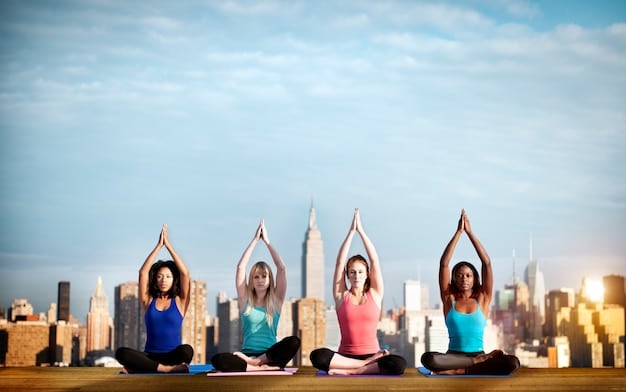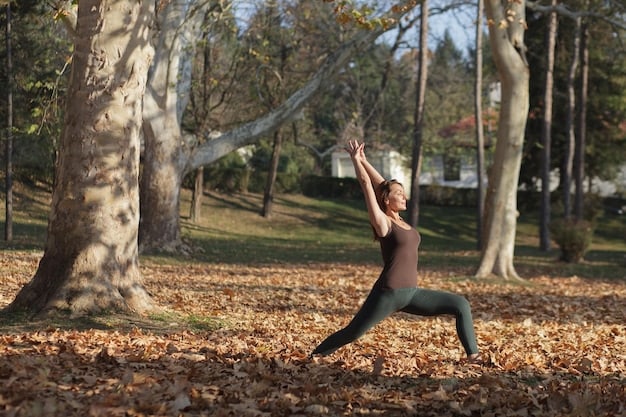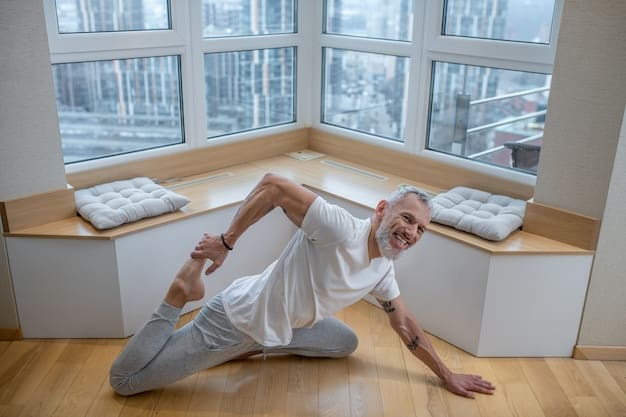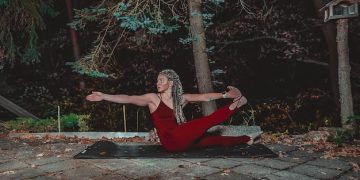Yoga for Athletes: 5 Poses to Enhance Performance & Prevent Injuries

Yoga for Athletes: Improve Performance and Prevent Injuries with These 5 Targeted Poses focuses on specific yoga asanas designed to enhance athletic performance by increasing flexibility, strength, and body awareness, while also minimizing the risk of common sports-related injuries.
Unlock your athletic potential with **Yoga for Athletes: Improve Performance and Prevent Injuries with These 5 Targeted Poses**. Designed to complement your training routine, incorporating these poses can optimize your strength, flexibility, and mental focus on and off the field.
The Athlete’s Advantage: Yoga for Enhanced Performance
Yoga isn’t just about relaxation; it’s a powerful tool for athletes seeking to elevate their performance. Athletes can improve flexibility, strength, and mental resilience through specific yoga poses by incorporating yoga into regular training routines.
This holistic practice promotes balance and body awareness as well as supports injury prevention, vital for maintaining peak athletic condition.

Flexibility and Range of Motion
Flexibility and range of motion are crucial for athletes across all disciplines. Performing yoga poses can enhance joint mobility and muscle elasticity, reducing the risk of strains and tears.
Strength and Stability
Many people don’t realize that yoga poses can be modified to build strength and stability. Through controlled movements and mindful engagement, athletes can develop core strength and improve overall athletic performance.
- Improved Power: By increasing flexibility, athletes can move more fluidly and generate greater power in their movements.
- Faster Recovery: Improved circulation enhances recovery, reducing inflammation and muscle soreness.
- Body Awareness: Practicing yoga cultivates body awareness which allows athletes to react efficiently and safely.
In summary, it provides a physical tool that facilitates balance and promotes injury prevention, which is absolutely vital for sustaining peak athletic performance.
Pose 1: Downward-Facing Dog (Adho Mukha Svanasana)
Downward-Facing Dog is foundational for athletes because it stretches tight hamstrings, calves, and shoulders, all of which are areas prone to stiffness in many athletes. This pose increases blood flow to the brain, promoting mental clarity.
Furthermore, the inverted position helps calm the nervous system, reducing stress and promoting relaxation.
How to Perform
- Start on your hands and knees, ensuring your hands are shoulder-width apart and your knees are hip-width apart.
- Press into your hands and lift your hips up and back, forming an inverted V-shape.
- Distribute your weight evenly between your hands and feet, keeping a slight bend in your knees if your hamstrings are tight.
- Hold the pose for 5–10 breaths, focusing on lengthening your spine and relaxing your neck.
Pose 2: Warrior II (Virabhadrasana II)
Warrior II is a powerful standing pose that builds strength in the legs and opens the hips, and stretches the groin and shoulders. It also improves balance and coordination, crucial for athletes in virtually all sports.
The pose can improve your body awareness, which helps athletes maintain form during intense activities.
How to Perform
- Start in a standing position with your feet about 4 feet apart. Turn your right foot out 90 degrees and your left foot in slightly.
- Bend your right knee directly over your right ankle, ensuring your knee doesn’t extend past your toes.
- Keep your torso upright and your shoulders relaxed. Extend your arms out to the sides, parallel to the floor.
- Gaze over your right hand and hold the pose for 5–10 breaths, then repeat on the other side.
Pose 3: Plank Pose (Phalankasana)
Plank Pose is an excellent core-strengthening exercise that engages multiple muscle groups simultaneously. This strengthens your abdomen, back, and shoulders. All of these will improve overall stability and endurance, which are required for any kind of athlete.
Plank Pose enhances posture and core stability, reducing the risk of lower back pain.
How to Perform
- Start in a push-up position with your hands shoulder-width apart and your body in a straight line from head to heels.
- Engage your core by drawing your belly button toward your spine.
- Keep your neck neutral and your glutes engaged, to avoid sagging in the hips.
- Hold the pose for 30–60 seconds, maintaining proper form and breathing deeply.
Pose 4: Pigeon Pose (Eka Pada Rajakapotasana) Variation
Pigeon Pose effectively targets the hip flexors and glutes, areas often tight for athletes who are regularly running, jumping, and squatting. This pose improves hip mobility and flexibility to maintain a full athletic form.
It is beneficial for relieving lower back pain and sciatica, which may be common in athletes.
How to Perform
- Start on your hands and knees. Bring your right knee forward toward your right wrist, positioning your right ankle near your left wrist.
- Extend your left leg straight back behind you, ensuring your hips are square to the front.
- Inhale and lengthen your spine, then exhale and fold forward over your right leg.
- Hold the pose for 5–10 breaths, then repeat on the other side.

Pose 5: Bridge Pose (Setu Bandhasana)
Bridge Pose is another great pose for athletes and helps to strengthen the back muscles, glutes, and hamstrings. Strengthening these areas can improves overall posterior chain strength which leads to enhanced athletic performance.
This pose counteracts the effects of prolonged sitting and improves circulation.
How to Perform
- Lie on your back with your knees bent and your feet flat on the floor, hip-width apart.
- Press into your feet and lift your hips off the floor, engaging your glutes and hamstrings.
- Clasp your hands together underneath your body and draw your shoulders back.
- Hold the pose for 5–10 breaths, then slowly lower your hips back to the floor.
Integrating Yoga into Your Training Routine
To maximize the benefits of yoga, it’s important for athletes to integrate it thoughtfully into their training schedules. Consistency and proper form are two very important elements because they contribute to injury prevention and overall progress. Be mindful, and listen to your body during yoga sessions.
Incorporate yoga during recovery days and post-workout to promote relaxation, reduce muscle soreness, and enhance overall performance.
When to Practice Yoga
Yoga can be integrated as a warm-up, cool-down, or dedicated practice within an athlete’s routine. For athletes who want to improve flexibility, the ideal situation might be to implement short yoga sessions before a workout.
Listen to Your Body
One of the most fundamental principles of yoga is listening to your body. Always work within your limits and modify poses as needed. Don’t push yourself beyond your comfort zone, especially if you’re new to yoga.
- Start Slowly: When introducing yoga, begin with shorter sessions and gradually increase the duration as your body adapts.
- Proper Alignment: Maintain proper alignment to maximize benefits and minimize the risk of injury.
- Stay Hydrated: Drink plenty of water before and after your yoga sessions to stay hydrated and support muscle recovery.
In conclusion, yoga offers numerous evidence based benefits for athletes. Therefore, proper planning and mindful practice make yoga a positive practice from any approach.
| Key Point | Brief Description |
|---|---|
| 💪 Strength | Yoga builds muscular strength and core stability. |
| 🧘 Flexibility | Enhances range of motion, joint mobility and muscle elasticity. |
| 🤕 Injury Prevention | Reduces risk of strains and tears, enhances body awareness. |
| 🧠 Mental Clarity | Yoga promotes calmness and enhances recovery. |
Frequently Asked Questions
▼
Athletes should aim for at least two to three yoga sessions per week to see noticeable improvements in flexibility, strength, and recovery. Consistency is key for getting all those great benefits.
▼
Both morning and evening yoga are great depending on your overall goals. Mornings can invigorate you for training, while evenings help the recovery process by relaxing muscles and calming the central nervous system.
▼
Yes, yoga enhances flexibility, strength, and body awareness, all of which are super important to preventing those common athletic injuries. Specific poses targeting tight muscles can significantly reduce the risk.
▼
Runners will typically benefit from poses like Downward-Facing Dog, Pigeon Pose, and Bridge Pose. These target the hamstrings, hips, and glutes, all of which are overused and prone to tightness in runners.
▼
Nope, you don’t necessarily need special equipment. A yoga mat is definitely recommended for comfort and grip. But other than that, just wear comfortable clothing that allows you to move freely!
Conclusion
Incorporating these five targeted yoga poses can significantly enhance athletic performance and reduce the risk of injuries. Athletes can achieve a balanced and resilient body by prioritizing flexibility, strength, and mindfulness to maximize their full potential.





